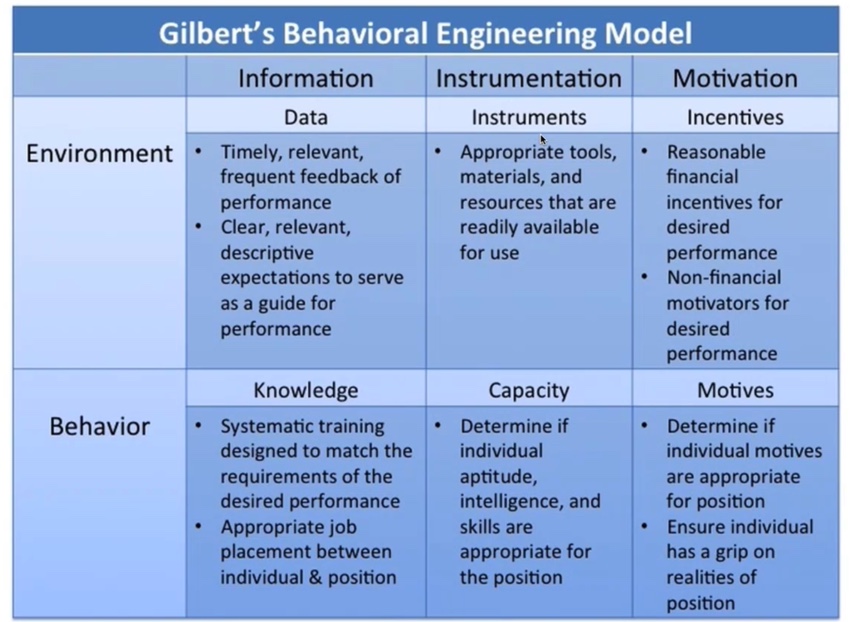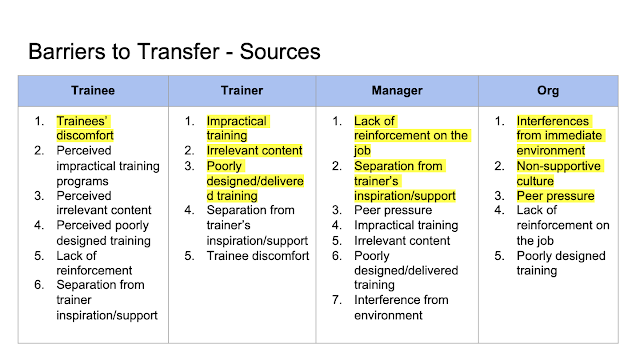Last week, my Human Performance Technology (HPT) class had a guest speaker session with Dr. Mohan Yang, an assistant professor at Old Dominion University in the Training Specialist concentration within the Occupational Technical Studies program. Dr. Yang's presentation focused on learning transfer, an important concept related to performance improvement. In simple terms, learning transfer means a learner's ability to apply what they've learned from a class or training program to a relevant, real-life situation (e.g., the workplace).
In addition to being an assistant professor, Dr. Yang is also the president of the Association for Educational Communications and Technology's Occupational Training and Performance division. He received his Ph.D. from Purdue University just over a year ago, and about four years ago, he took the HPT class I'm taking now. In fact, he told our group HPT was one of his favorite classes at Purdue.
Dr. Yang's presentation underscored many concepts my classmates and I have been learning this term. For example, he said, "When you identify a performance-related issue, first you will need to dig out the root cause." From there, he said, you can review Gilbert's (1996) Behavioral Engineering Model to determine which of the six factors (i.e., data, instruments, incentives, knowledge, capacity, or motives) best relates to the cause. Determining the correct factor can help a performance consultant identify the appropriate intervention to address the issue.
Here's a copy of Gilbert's model from Dr. Yang's presentation:
In my class, we have been executing the tasks Dr. Yang summarized to analyze performance problems and propose solutions that align with those problems.
Interestingly, seventy-five percent of performance problems stem from issues in the environment, which are issues training programs cannot adequately address. On the contrary, training is best suited as a response to a gap in workers' knowledge and skills. So, as we've learned in class, though many organization leaders request training to resolve performance issues, training is rarely the suitable solution.
And, even when training is the appropriate answer, it cannot stand alone. Various factors, especially environmental ones, can stand in the way of learning transfer. So, even when trainees demonstrate competency in the learning context (i.e., the place where learning occurs), after they return once again to the performance context (i.e., the place where the trainee must ultimately apply what they've learned), their performance of new skills often decreases to pre-training levels over time.
To manage this common problem, we first must ask why. What are the barriers to transfer?
Baldwin and Ford (1988) categorized transfer determinants into three categories, namely trainee characteristics, training design, and work environment. The major players for each category are, respectively, the trainees, the trainers, and managers/supervisors.
Understanding the major players can help you pinpoint the barriers and strategize accordingly. Environmental issues, such as lack of reinforcement of new skills on the job, are common obstacles.
It's also helpful to look at training from a timeline perspective: before, during, and after. The image below features a list of some of the typical issues related to each phase.
Another important aspect to consider is the source of the resistance. Because issues of transfer vary from one situation to the next, the source could be the trainees, trainers, management, or even the organization itself.
Once you have identified the barriers, it's time to make a change. Dr. Yang recommends Lewin's (1951) change model, in which you "unfreeze" the status quo, make change by way of learning (as well as decreasing barriers or increasing support), and then "refreeze" once the change has occurred. Of course, because organizations must constantly evolve, this process is cyclical.
Dr. Yang is now passionate about authentic learning as a means to encourage learning transfer. Authentic learning requires bridging the gap between learning and performance contexts by creating realistic settings for learners to practice relevant, real-life tasks. In Dr. Yang's words, "How do you create a realistic environment and realistic, authentic task that captures the complexity of a real project in the performance context?"
Dr. Yang's current emphasis on authentic learning for transfer seems intuitively plausible. The more closely the learning context and learning tasks can resemble the performance context and its tasks, the easier it seems it will be for trainees to transfer their new skills. This approach, along with its incorporation of expert modeling and interactive practice opportunities, is one I will keep in mind when considering prescribing learning solutions to relevant performance problems.
References
"Transfer" by Nick Youngson, n.d., The Blue Diamond Gallery (https://www.thebluediamondgallery.com/highway-signs/t/transfer.html). CC BY-SA 3.0.
Yang, M. (2022, July 25). Transfer of training: A pathway to performance. Mediaspace. https://mediaspace.itap.purdue.edu/media/EDCI+528+%28HPT%29+A+Mohan+YangA+Transfer+of+Training/1_x9be3sp9






Comments
Post a Comment